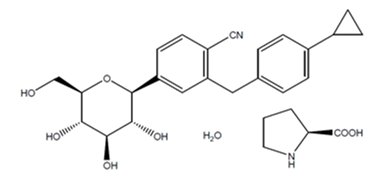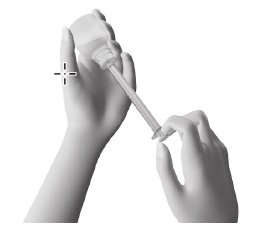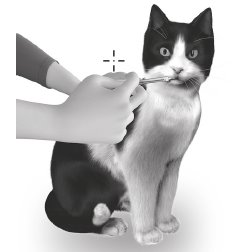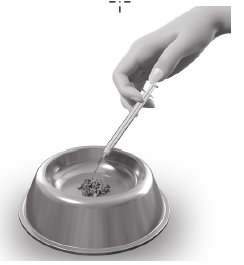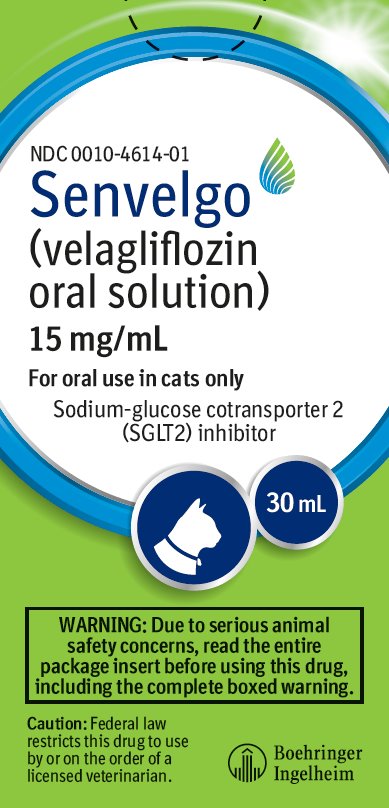Label: SENVELGO- velagliflozin solution
- NDC Code(s): 0010-4614-01, 0010-4614-02
- Packager: Boehringer Ingelheim Animal Health USA Inc.
- Category: PRESCRIPTION ANIMAL DRUG LABEL
- DEA Schedule: None
- Marketing Status: New Animal Drug Application
Drug Label Information
Updated April 24, 2024
If you are a consumer or patient please visit this version.
- Download DRUG LABEL INFO: PDF XML
- Official Label (Printer Friendly)
- SPL UNCLASSIFIED SECTION
- Caution:
-
BOXED WARNING
(What is this?)
WARNING: DIABETIC KETOACIDOSIS/EUGLYCEMIC DIABETIC KETOACIDOSIS
- -
- Cats treated with SENVELGO may be at an increased risk of diabetic ketoacidosis or euglycemic ketoacidosis (see Adverse Reactions). As diabetic ketoacidosis and euglycemic ketoacidosis in cats treated with SENVELGO may result in death, development of these conditions should be treated promptly, including insulin administration and discontinuation of SENVELGO (see Monitoring).
- -
- Due to the risk of developing diabetic ketoacidosis or euglycemic ketoacidosis, do not use SENVELGO in cats with diabetes mellitus who have previously been treated with insulin, who are receiving insulin, or in cats with insulin-dependent diabetes mellitus (see Contraindications).
- -
- SENVELGO should not be initiated in cats with anorexia, dehydration, or lethargy at the time of diagnosis of diabetes mellitus or without appropriate screening tests (see Animal Safety Warnings).
-
Description:
SENVELGO® (velagliflozin oral solution) equal to velagliflozin L-proline H2O 20.051 mg/mL, is a clear, colorless to slightly yellow, to slightly brown, liquid multi-dose preparation consisting of 1.5% w/v velagliflozin in an aqueous mixture of propylene glycol and ethanol intended for oral use in cats. SENVELGO is an orally active, sodium-glucose cotransporter 2 (SGLT2) inhibitor.
The chemical name of velagliflozin is 2-(4-cyclopropyl-benzyl)-4-((2S,3R,4R,5S,6R)-3,4,5-trihydroxy-6-hydroxymethyltetrahydropyran-2-yl)-benzonitrile. It forms a co-crystal with L-proline ((S)-pyrrolidine-2-carboxylic acid) as a monohydrate and velagliflozin, L-proline and H2O are in 1:1:1 ratios. Its empirical formula is C23H25NO5 x C5H9NO2 x H2O, its molecular formula is C28H36N2O8, and its structural formula is:
- Indication:
-
Dosage and Administration:
Always provide the Client Information Sheet with each prescription.
Dosing instructions:
The SENVELGO dose is 0.45 mg/lb of body weight (1 mg/kg), once daily regardless of blood glucose level. The dose may be administered directly into the mouth or with a small amount of wet food. Do not mix into food. The solution should be given at approximately the same time every day. If a dose is missed, it should be given as soon as possible on the same day. If the cat vomits within 30 minutes of dosing, the dose can be repeated.
SENVELGO should be administered using the dosing syringe provided in the package. The dosing syringe fits onto the bottle and has a body weight scale with increments per pound of body weight. The dose should be rounded down to the nearest pound. After administration, close the bottle tightly with the cap. If needed, the syringe can be cleaned with a clean, dry cloth.
Prior to initiation of treatment:
Prior to initiation of SENVELGO, the veterinarian should ensure the cat is alert, active, eating, and drinking. The veterinarian should conduct a physical examination, obtain a medical history, CBC, serum chemistry, serum fructosamine, and urinalysis including evaluation for ketonuria (see Animal Safety Warnings).
If there is a delay of more than a week between diagnosis of diabetes mellitus and initiation of SENVELGO, the veterinarian should re-evaluate the cat with a full physical examination and updated history to ensure the cat still meets the criteria described above. A delay of more than a week between diagnosis and starting SENVELGO may increase the risk of developing diabetic ketoacidosis.
Monitoring of cats receiving SENVELGO:
Sudden onset of hyporexia/anorexia, lethargy, dehydration, or weight loss in cats receiving SENVELGO should prompt immediate discontinuation of SENVELGO and assessment of diabetic ketoacidosis, regardless of blood glucose level.
Evaluate for ketonuria 2 to 3 days after initiation of treatment and approximately 7 days after initiation of treatment and anytime the cat shows signs of illness.If ketonuria is present, discontinue SENVELGO and promptly treat with insulin, even if blood glucose is normal.
During the first 4 weeks after initiation of SENVELGO, glycemic control and clinical improvement should be evaluated.
- •
- A physical examination, blood glucose curve, serum fructosamine, and body weight should be assessed at 1 and 4 weeks after initiating SENVELGO.
- •
- SENVELGO should be discontinued, and initiation of insulin considered, in cats demonstrating poor glycemic control (weight loss, average blood glucose from a glucose curve > 300 mg/dL or fructosamine values suggesting poor control (> 450 µmol/L) after 4 weeks of treatment.
During ongoing treatment with SENVELGO, blood glucose, fructosamine, urinary ketones, serum chemistry, body weight, hydration status, and clinical signs of diabetes mellitus should be routinely monitored.
- •
- Presence of ketonuria should prompt discontinuation of SENVELGO and transition to insulin.
- •
- Cats with increasing or persistently elevated triglyceride or cholesterol levels may have declining glycemic control or pancreatitis, and may be at risk of developing diabetic ketoacidosis or euglycemic diabetic ketoacidosis (diabetic ketoacidosis with normal blood glucose levels). Consider further evaluation and discontinuation of SENVELGO in these cats.
- •
- Increasing or persistently elevated feline pancreas-specific lipase (fPL) should prompt further evaluation for pancreatitis and consideration of discontinuation of SENVELGO.
- •
- Initial mild weight loss may be seen with SENVELGO associated with its mode of action (glucosuria and caloric wasting). Unintentional weight loss which doesn’t improve or stabilize within 7 days may indicate the need to evaluate for concurrent disease and consideration of discontinuation of SENVELGO (see Adverse Reactions).
- •
- If clinical signs of illness occur, evaluate the cat as soon as possible to ensure it is not at risk for diabetic ketoacidosis or euglycemic diabetic ketoacidosis (see Animal Safety Warnings).
- •
- SENVELGO should be discontinued if the cat’s clinical condition declines and/or glycemic control worsens after initial improvement.
Cats may present with diabetic ketoacidosis and a normal blood glucose concentration (euglycemic diabetic ketoacidosis). Delay in recognition and treatment of diabetic ketoacidosis and euglycemic diabetic ketoacidosis may result in increased morbidity and mortality.
Development of diabetic ketoacidosis or euglycemic ketoacidosis requires the following actions:
- •
- Discontinuation of SENVELGO
- •
- Prompt initiation of insulin therapy
- •
- Administration of dextrose or other carbohydrate source, regardless of blood glucose concentration
- •
- Appropriate nutritional support should be promptly initiated to prevent or treat hepatic lipidosis.
-
Contraindications:
Do not use SENVELGO in cats with diabetes mellitus who have previously been treated with insulin, who are receiving insulin, or in cats with insulin-dependent diabetes mellitus. The use of SENVELGO in cats with insulin-dependent diabetes mellitus, or the withdrawal of insulin and initiation of SENVELGO, is associated with an increased risk of diabetic ketoacidosis or euglycemic diabetic ketoacidosis and death.
-
Warnings:
User Safety Warnings: Not for use in humans.Keep out of reach of children.
Wash hands after use. This product may cause mild eye irritation. Avoid contact with eyes. If the product accidentally gets into the eyes, rinse eyes immediately with plenty of water; if wearing contact lenses, rinse the eyes first then remove contact lens(es) and continue to rinse for 5-10 minutes. If eye irritation continues or accidental ingestion occurs, seek medical advice and provide this product information to the physician. Exposure to product may induce local or systemic allergic reaction in sensitized individuals. Oral exposure to velagliflozin may cause transient effects such as increased renal glucose excretion, increased urine volume, and hypoglycemia.
Animal Safety Warnings:
SENVELGO should not be initiated in cats with:
- •
- Anorexia, dehydration, or lethargy at the time of diagnosis of diabetes mellitus as it may indicate the presence of other concurrent disease and increase the risk of diabetic ketoacidosis.
- •
- Ketonuria, ketonemia, or suspected diabetic ketoacidosis or a history of the same
- •
- Clinical suspicion of pancreatitis within the last month based on clinical signs, serum fPL > 12 mcg/L, and/or diagnostic imaging consistent with pancreatitis.
- •
- Chronic or unresponsive diarrhea
- •
- Cachexia
- •
- Bilirubin > 0.5 mg/dL
- •
- Creatinine > 2 mg/dL
SENVELGO may cause a mild increase in serum creatinine, blood urea nitrogen (BUN), phosphorus, and sodium in cats with or without chronic kidney disease within weeks of starting therapy, followed by a stabilization of values.
Cats with baseline creatinine between 1.6 and 2 mg/dL when SENVELGO treatment is started should be closely monitored for signs of volume depletion/dehydration and body weight loss. Renal function should be monitored within the first week of treatment initiation and then according to standard chronic kidney disease guidelines. SENVELGO has not been evaluated in cats with baseline creatinine > 2 mg/dL.
Cats should be screened for urinary tract infections and treated, if indicated, when initiating SENVELGO. Cats treated with SENVELGO should be monitored for urinary tract infections and treated promptly.
Cats should be evaluated for concurrent disease including pancreatitis, infectious disease, urinary tract infection, neoplasia, and hypersomatotropism (acromegaly) before initiating and while receiving SENVELGO as these conditions may increase the risk of developing diabetic ketoacidosis.
Persistently low or worsening serum chloride values compared to the pre-treatment value may indicate the development of diabetic ketoacidosis or euglycemic diabetic ketoacidosis.
SENVELGO may cause increased serum calcium and persistent elevations may require additional diagnostics. Persistent elevated calcium has been associated with increased risk of calcium-containing urolith formation in other SGLT2 inhibitors.
Cats should be closely monitored for development of diabetic ketoacidosis or euglycemic diabetic ketoacidosis (for example, ketonuria or anorexia) after stopping SENVELGO. Euglycemia may persist for 2 to 3 days after stopping SENVELGO.
Keep SENVELGO in a secure location out of reach of dogs, cats, and other animals to avoid accidental ingestion or overdose.
-
Precautions:
Consider temporarily discontinuing SENVELGO during times of decreased caloric intake, such as surgery or decreased appetite, as continued administration of SENVELGO may increase the risk of diabetic ketoacidosis.
SENVELGO contains propylene glycol. When cats are administered SENVELGO at the 1 mg/kg/day dose, cats receive 40 mg/kg/day of propylene glycol. Exceeding 80 mg/kg/day of propylene glycol may result in excess hepatic glycogen stores. Use caution when administering SENVELGO to cats receiving other products that contain propylene glycol.
Glucosuria may persist for 2-3 days after stopping SENVELGO. In cats receiving SENVELGO, glucosuria is not a reliable indicator for monitoring glycemic control.
The safety and effectiveness of SENVELGO has not been evaluated in cats with chronic kidney disease (IRIS (International Renal Interest Society) Stages 3 and 4).
The concurrent use of volume depleting drugs in cats treated with SENVELGO has not been evaluated.
SENVELGO has not been evaluated with concurrent use of insulin or other blood glucose lowering treatments.
The safety and effectiveness of SENVELGO in breeding, pregnant, and lactating cats has not been evaluated.
-
Adverse Reactions:
Two hundred fifty-two (252) cats with diabetes mellitus were enrolled in a 180-day multicenter field study. Safety data were evaluated in 252 cats treated with at least one dose of SENVELGO. Regardless of blood glucose level, cats received SENVELGO at a dose of 0.45 mg/lb once daily.
The most common adverse reactions were diarrhea or loose stool, weight loss, vomiting, polyuria, polydipsia, and elevated blood urea nitrogen (BUN). The table below summarizes the adverse reactions reported in the study.
Adverse Reactions
Frequency (N=252)
Number (%)
Diarrhea (including loose stool)
132 (52.3%)
Weight loss*
111 (44%)
Vomiting
92 (36.5%)
Polyuria
46 (18.3%)
Polydipsia
42 (16.7%)
BUN†
39 (15.5%)
Anorexia or hyporexia
34 (13.5%)
Hypersalivation and/or gagging
33 (13.1%)
Urine specific gravity > 1.060
29 (11.5%)
Dehydration
28 (11.1%)
Lethargy
20 (7.9%)
Polyphagia
19 (7.5%)
Urinary tract infections/cystitis
18 (7.1%)
Diabetic ketoacidosis or euglycemic diabetic ketoacidosis‡
18 (7.1%)
Hypercalcemia
16 (6.3%)
Ketonuria§
14 (5.6%)
Inappropriate urination
14 (5.6%)
Death or euthanasia
13 (5.2%)
Elevated AST and/or ALT**
12 (4.8%)
Hypertriglyceridemia††
12 (4.8%)
Hyperphosphatemia
12 (4.8%)
Elevated fPL
11 (4.4%)
Pancreatitis
10 (4.0%)
Elevated creatinine
9 (3.6%)
Hepatic lipidosis
6 (2.4%)
Urinary incontinence
3 (1.2%)
- *Approximately 80 cats had weight loss during the first week of treatment, likely due to dehydration and/or caloric wasting from glucosuria.
- †Most cats had elevations ≤ 1.5X upper limit of normal (ULN).
- ‡All but 5 cases occurred within 2 weeks of starting SENVELGO.Twelve of these cats had euglycemic diabetic ketoacidosis.
- §These cats did not progress to diabetic ketoacidosis and all but one developed ketonuria within a week of starting SENVELGO. The cats discontinued SENVELGO and transitioned to insulin.
- **Four of these cats had AST (aspartate aminotransferase) and/or ALT (alanine aminotransferase) > 2X ULN.
- ††These cats sometimes also had elevated cholesterol.
The following adverse reactions were seen in the study with < 1% frequency: elevated creatine kinase (> 3X ULN), hypoglycemia without clinical signs (glucose ≤ 50 mg/dL), anemia, abnormal behavior, bradycardia, and dermatitis.
Ketonuria and diabetic ketoacidosis: Thirty-two (32) cats developed ketonuria, diabetic ketoacidosis or euglycemic diabetic ketoacidosis and were removed from the study. Twenty-six (26) of these cats developed ketonuria, diabetic ketoacidosis, or euglycemic diabetic ketoacidosis within the first 7 days of treatment with SENVELGO. Thirteen (13) of these cats developed ketonuria without further progression to diabetic ketoacidosis or euglycemic ketoacidosis and transitioned to insulin. An additional thirteen (13) cats developed diabetic ketoacidosis or euglycemic ketoacidosis. Nine cats recovered after hospitalization and intensive treatment. Three of the 9 cats had concurrent conditions: hepatopathy (1), hepatic lipidosis (1), and pancreatitis and hepatic lipidosis (1). Four of the 13 cats were euthanized; three because the owners declined treatment and one cat was euthanized after not responding to hospitalization and intensive treatment.
Six cats developed ketonuria, diabetic ketoacidosis or euglycemic diabetic ketoacidosis after the first 7 days of treatment. One cat developed ketonuria without progression to diabetic ketoacidosis or euglycemic ketoacidosis after more than 4 months on SENVELGO. Five cats developed diabetic ketoacidosis or euglycemic ketoacidosis. Two cats (one with concurrent pancreatitis and hepatic lipidosis) were treated and recovered. One with concurrent pancreatitis was treated and recovered but died several days later. Two of the five cats were euthanized; one cat was euthanized after poor response to hospitalization and intensive therapy; and one was euthanized due to declining condition unrelated to diabetic ketoacidosis.
Thirty-eight enrolled cats had been previously treated with insulin. Of those 38 cats, 12 (32%) developed ketonuria, diabetic ketoacidosis, or euglycemic diabetic ketoacidosis during the first week and were removed from the study. These 12 cats are included in the 26 cases reported above and represent 46% of the cases removed in the first week of treatment due to ketonuria or ketoacidosis.
Death and euthanasia: Nineteen cats died (3) or were euthanized (16) during the study, or shortly following removal from the study, with thirteen possibly related to SENVELGO use or declining glycemic control. In addition to 6 of the cases associated with diabetic ketoacidosis described above, euthanasia was associated with the following conditions (number of cats): acute renal failure within a week of starting SENVELGO (1), worsening or emergent urinary incontinence associated with poor glycemic control (2), worsening polyuria/polydipsia and inappropriate urination (1), progressive signs of diabetes mellitus (1), declining condition and suspected pancreatitis (1), azotemia and lack of effect within a week of starting SENVELGO and possible concurrent hypersomatotropism (1).
-
Contact Information:
To report suspected adverse drug events, for technical assistance, or to obtain a copy of the Safety Data Sheet (SDS), contact Boehringer Ingelheim Animal Health at 1-888-637-4251. For additional information about adverse drug experience reporting for animal drugs, contact FDA at 1-888-FDA-VETS or online at www.fda.gov/reportanimalae.
-
Information for Cat Owners:
Please provide and review the Client Information Sheet with cat owners to ensure they understand the entire contents before SENVELGO is administered. The Client Information Sheet contains important information regarding the use of SENVELGO. Owners should be advised to discontinue SENVELGO and contact a veterinarian immediately if their cat develops anorexia, lethargy, vomiting, diarrhea, or weakness.
-
Clinical Pharmacology:
Mechanism of Action:
Velagliflozin is an inhibitor of sodium-glucose cotransporter 2 (SGLT2), the renal transporter responsible for reabsorption of glucose from the glomerular filtrate back into the circulation. By inhibiting SGLT2, velagliflozin reduces the reabsorption of filtered glucose and lowers the renal threshold for glucose, thereby increasing urinary glucose excretion.
Pharmacokinetics: In a laboratory study conducted to determine the prandial state of maximum exposure,systemic exposure for velagliflozin was greater in the fasted state than in the fed state by170% for the mean maximum observed plasma concentration (Cmax), and by 45% for the mean area under the plasma concentration versus time curve (AUC) from dosing (time 0) to the last quantifiable concentration (AUC0-last), respectively.
In a well-controlled, laboratory margin of safety study in healthy, adult cats (see Target Animal Safety), after repeat daily oral dosing for six months, a slight to moderate increase in exposure to velagliflozin was observed. In addition, a tendency for a less than dose proportionalincrease of maximum plasma concentration (Cmax) and exposure (AUC) over the tested dose range was noted.
Following oral administration of SENVELGO in cats at 1 mg/kg, velagliflozin was rapidly absorbed with a median time to maximum concentration of 0.25 hours. The velagliflozin mean (± standard deviation) Cmax was 1030 (± 361) ng/mL and the mean AUC0-last to the last quantifiable plasma concentration was 3295 (± 1098) day*ng/mL. The elimination half-life of velagliflozin was 3.68 (± 0.34) hours.
-
Effectiveness
Two hundred and fifty-two (252) cats diagnosed with diabetes mellitus were enrolled in a 180-day multicenter field study. The cats included various purebred and mixed breed cats ranging in age from 4 to 18 years and in weight from 5.7 to 26.5 lbs (2.6 to 12 kg). Cats were administered SENVELGO at a dose of 0.45 mg/lb (1 mg/kg) orally, once daily, regardless of blood glucose level, beginning on Day 0. Cats were evaluated at Days 2 or 3, and Days 7 and 30 and then monthly.
Treatment success was evaluated on Day 30 and was defined as improvement in at least one clinical sign of diabetes mellitus (polyuria, polydipsia, unintended weight loss, polyphagia, or diabetic neuropathy) and improvement in at least one blood glucose variable (blood glucose curve mean or serum fructosamine).
Of 198 cats included in the effectiveness-evaluable population:
- -
- 175 cats (88.4%) were considered a treatment success on Day 30 (lower bound of the two-sided 90% confidence interval was 84%).
- -
- Mean blood glucose decreased from 446.4 mg/dL (single fasted sample) prior to Day 0 to 169.8 mg/dL (blood glucose curve mean) on Day 30
- -
- Mean fructosamine levels decreased from 551.4 µmol/L prior to Day 0 to 332.0 µmol/L on Day 30.
- -
- Improvements in the clinical signs of polyuria, polydipsia, body weight, polyphagia, and diabetic neuropathy on Day 30 were observed in 125/177 (71%), 128/176 (73%), 133/167 (80%), 33/80 (41%), and 7/30 cats (23%), respectively.
- -
- 157 cats completed the 180-day study
-
Target Animal Safety:
In a well-controlled laboratory margin of safety study, SENVELGO was administered orally to fasted, healthy, 8 to 9 month old cats at 0, 1, 3, or 5 mg/kg body weight(corresponding to 1X, 3X or 5X the intended labeled point dose of 1 mg/kg) once daily for26 weeks (6 months). Control cats (0 mg/kg) received saline at a volume equal to the 5 mg/kg dose. There were eight cats per group (4 females, 4 males). All cats survived the study and there were no SENVELGO-related effects on ophthalmic examinations, indirect systolic blood pressure measurements, and blood coagulation parameters. Hypersalivation and vomiting after dose administration occurred infrequently and was only observed in the groups that received SENVELGO.
During physical examinations on Days 14 and 28, there was a drug-related decrease in heart rate (< 140 bpm) in the cats that received SENVELGO compared to the control cats. There were no other drug-related effects on physical examinations.
Polydipsia, glucosuria, decreased urine creatinine, and diarrhea were reported more frequently in cats that received SENVELGO than in control cats.
Reddish, mucoid feces were observed in three instances in the 1X group cats. One cat in the 5X group had decreased activity, vomiting, and reduced feed consumption for one day, and reddened rectal mucous membranes were observed over the next 5 days. Two cats (3X and 5X groups) were each observed to have a reddened prepuce with white-yellow discharge twice during the study that was not associated with abnormal urinalyses.
Food consumption was higher in the cats that received SENVELGO compared to the control cats. The rate of body weight gain was lower in the 5X group cats compared to cats in the control, 1X and 3X groups.
There were drug-related increases in reticulocyte count, mean corpuscular hemoglobin, mean corpuscular volume, and Heinz body percentage, and a decrease in mean corpuscular hemoglobin concentration in the cats that received SENVELGO compared to control cats. None of the cats showed any clinical signs of anemia and the number of erythrocytes, hemoglobin, and hematocrit values were normal. There was no effect of SENVELGO on white blood cells and platelets.
There were drug-related increases in serum magnesium, albumin, cholesterol, and triglycerides in the cats that received SENVELGO, with some magnesium, serum albumin and triglyceride values above the reference range. There was a drug-related decrease in mean BUN in the cats that received SENVELGO. There were no other treatment-related changes in serum chemistry parameters, including serum glucose and symmetric dimethylarginine (SDMA).
A reticular pattern was observed on the surface of the liver of one control, three 1X, four 3X, and three 5X group cats.
- How Supplied:
- Storage Information:
-
SPL UNCLASSIFIED SECTION
Approved by FDA under NADA # 141-568
Marketed by:
Boehringer Ingelheim Animal Health USA Inc.
Duluth, GA 30096
SENVELGO® is a registered trademark of Boehringer Ingelheim Vetmedica GmbH, used under license.
© 2024 Boehringer Ingelheim Animal Health USA Inc. All rights reserved.
Revised 03/2024
L65280324
-
Client Information Sheet
Senvelgo®
(velagliflozin oral solution)
15 mg/mL
For oral use in cats only
Sodium-glucose cotransporter 2 (SGLT2) inhibitor
The Client Information Sheet contains important information about SENVELGO® (velagliflozin oral solution). You should read this information before you start giving SENVELGO to your cat and review it each time the prescription is refilled as there may be new information. This sheet is provided only as a summary and does not take the place of instructions from your veterinarian. Talk with your veterinarian if you do not understand any of this information or if you want to know more about SENVELGO.
What is SENVELGO?
SENVELGO is a drug used to lower high blood glucose (sugar) in otherwise healthy cats with diabetes mellitus not previously treated with insulin. SENVELGO causes sugar to be passed in the urine by preventing the kidneys from pulling sugar back into the blood.
What is diabetes mellitus (commonly called diabetes)?
Diabetes happens when a cat does not make enough insulin (insulin dependent), or the cat’s cells do not react correctly to insulin (insulin resistant). Some cats may begin as insulin resistant but may slowly become insulin dependent over time. Sugar is an important source of energy for the cells in your cat’s body. Cats with diabetes have high blood sugar (hyperglycemia) because the sugar cannot get into the cells to be used for energy. Insulin helps sugar get into your cat’s cells for energy. There is no test available for your veterinarian to know if your cat makes enough insulin or not. Cats with diabetes may show an increased thirst, urination, and hunger; weight loss; and/or weakness in the back legs. Cats who are insulin dependent should not be treated with SENVELGO because it can cause serious, sometimes fatal, side effects.
What are some of the possible side effects of SENVELGO?
SENVELGO may be associated with side effects. Serious side effects have happened with or without warning and sometimes led to death in cats treated with SENVELGO. Serious side effects may require your cat to be hospitalized and to be given specific treatments, including insulin. The most common side effects are diarrhea or loose stool, vomiting, and weight loss.
STOP SENVELGO AND CONTACT YOUR VETERINARIAN IMMEDIATELY IF YOU NOTICE ANY OF THE FOLLOWING CHANGES OR SIDE EFFECTS IN YOUR CAT:
- •
- Less interest in food or not eating
- •
- Lack of energy or change in normal activity
- •
- Vomiting or diarrhea
- •
- Weakness, difficulty walking or standing
What should I discuss with my veterinarian before giving SENVELGO?
Tell your veterinarian if:
- •
- Your cat is currently or was previously treated with insulin or other anti-diabetic medications.
- •
- Your cat has been previously diagnosed with diabetic ketoacidosis (a buildup of acids in the blood) or liver or kidney disease.
- •
- Your cat has any other serious health conditions such as acute vomiting, diarrhea, decreased appetite, or weight loss.
- •
- Your cat is taking other medications including prescription drugs and over-the-counter medication.
- •
- Your cat is pregnant, nursing, or you intend to breed him/her.
- •
- Your cat has any planned procedures that involve anesthesia, such as surgery or dentistry.
When should I take my cat to the veterinarian?
- •
- It is very important to take your cat to the veterinarian twice during the first week of taking SENVELGO to monitor your cat for side effects even if your cat seems fine. Your cat should be examined by your veterinarian 2 or 3 days after starting SENVELGO and again about 7 days after starting SENVELGO.
- •
- It is also important to take your cat to the veterinarian immediately if your cat is showing signs of illness including decreased appetite or decreased thirst, vomiting, weakness, decreased activity or depressed attitude.
- •
- It is important to discuss your cat’s response to SENVELGO at regular checkups.
- •
- Your veterinarian will determine if your cat is responding as expected and whether your cat should continue using SENVELGO.
What kind of results can I expect when my cat is on SENVELGO for diabetes mellitus?
You may see a decrease in the amount of thirst, urine, and hunger in your cat.
How do I give SENVELGO to my cat?
SENVELGO should be given directly into your cat’s mouth with the provided dosing syringe or placed on a small amount of wet food your cat will eat completely (approximately 1 to 3 teaspoons of food). The dosing syringe fits into the bottle opening and has a body weight scale to use for measuring the dose. The body weight scale on the syringe is made to give the amount of SENVELGO prescribed by your veterinarian.
Follow your veterinarian’s instructions for how much and how often to give SENVELGO.
- -
- Remove the cap from the bottle and gently push the end of the dosing syringe into the bottle opening.
- -
- Turn the bottle/syringe upside down.
- -
- Pull the plunger back and fill the dosing syringe to the dose prescribed by your veterinarian.
- -
- Turn the bottle upright and remove the dosing syringe from the bottle.
- -
- Put the end of the dosing syringe into your cat’s mouth and push the plunger to give the dose.
- -
- Or put the dose next to or on top of a small amount of wet food. Do not mix into food. If SENVELGO is put onto food, make sure your cat eats the food and the entire dose.
If your cat vomits within 30 minutes of giving the SENVELGO dose, your cat can be given the same dose again. If your cat vomits more than 30 minutes after giving SENVELGO, do not give SENVELGO again until the next scheduled dose. After dosing, replace the cap on the bottle and close tightly. If needed, the syringe can be cleaned with a clean, dry cloth.
What should I do if my cat gets more than the prescribed dose?
Contact your veterinarian if you see any side effects. If no side effects are seen, return to the dose prescribed by your veterinarian the following day.
What should I do if my cat gets less than the prescribed dose, or I miss a dose?
- •
- If your cat gets less than the prescribed dose, return to the dose prescribed by your veterinarian the following day.
- •
- If a dose is missed, it should be given as soon as possible on the same day.
How should I store SENVELGO?
SENVELGO can be stored at or below 77°F (25°C) with excursions permitted up to 104°F (40°C). Once the bottle is opened, use the contents within six months.
Keep SENVELGO in a secure location out of reach of dogs, cats, and other animals to avoid accidental ingestion or overdose.
Approved by FDA under NADA # 141-568
SENVELGO® is a registered trademark of Boehringer Ingelheim Vetmedica GmbH, used under license.
© 2024 Boehringer Ingelheim Animal Health USA Inc. All rights reserved.
Revised 03/2024
- PRINCIPAL DISPLAY PANEL – 30 mL Carton
-
INGREDIENTS AND APPEARANCE
SENVELGO
velagliflozin solutionProduct Information Product Type PRESCRIPTION ANIMAL DRUG Item Code (Source) NDC:0010-4614 Route of Administration ORAL Active Ingredient/Active Moiety Ingredient Name Basis of Strength Strength VELAGLIFLOZIN PROLINE (UNII: EQE2P2T77I) (VELAGLIFLOZIN - UNII:FV2YU8SL0P) VELAGLIFLOZIN 15 mg in 1 mL Inactive Ingredients Ingredient Name Strength PROPYLENE GLYCOL (UNII: 6DC9Q167V3) ALCOHOL (UNII: 3K9958V90M) Product Characteristics Color Score Shape Size Flavor HONEY Imprint Code Contains Packaging # Item Code Package Description Marketing Start Date Marketing End Date 1 NDC:0010-4614-01 1 in 1 CARTON 1 30 mL in 1 BOTTLE, PLASTIC 2 NDC:0010-4614-02 1 in 1 CARTON 2 12 mL in 1 BOTTLE, PLASTIC Marketing Information Marketing Category Application Number or Monograph Citation Marketing Start Date Marketing End Date NADA NADA141568 10/01/2023 Labeler - Boehringer Ingelheim Animal Health USA Inc. (007134091)


